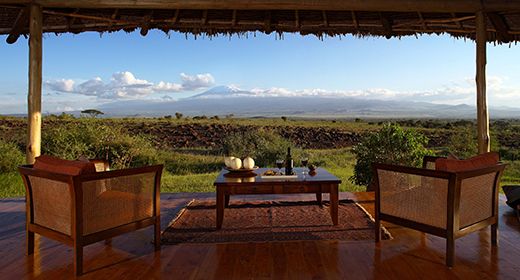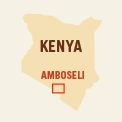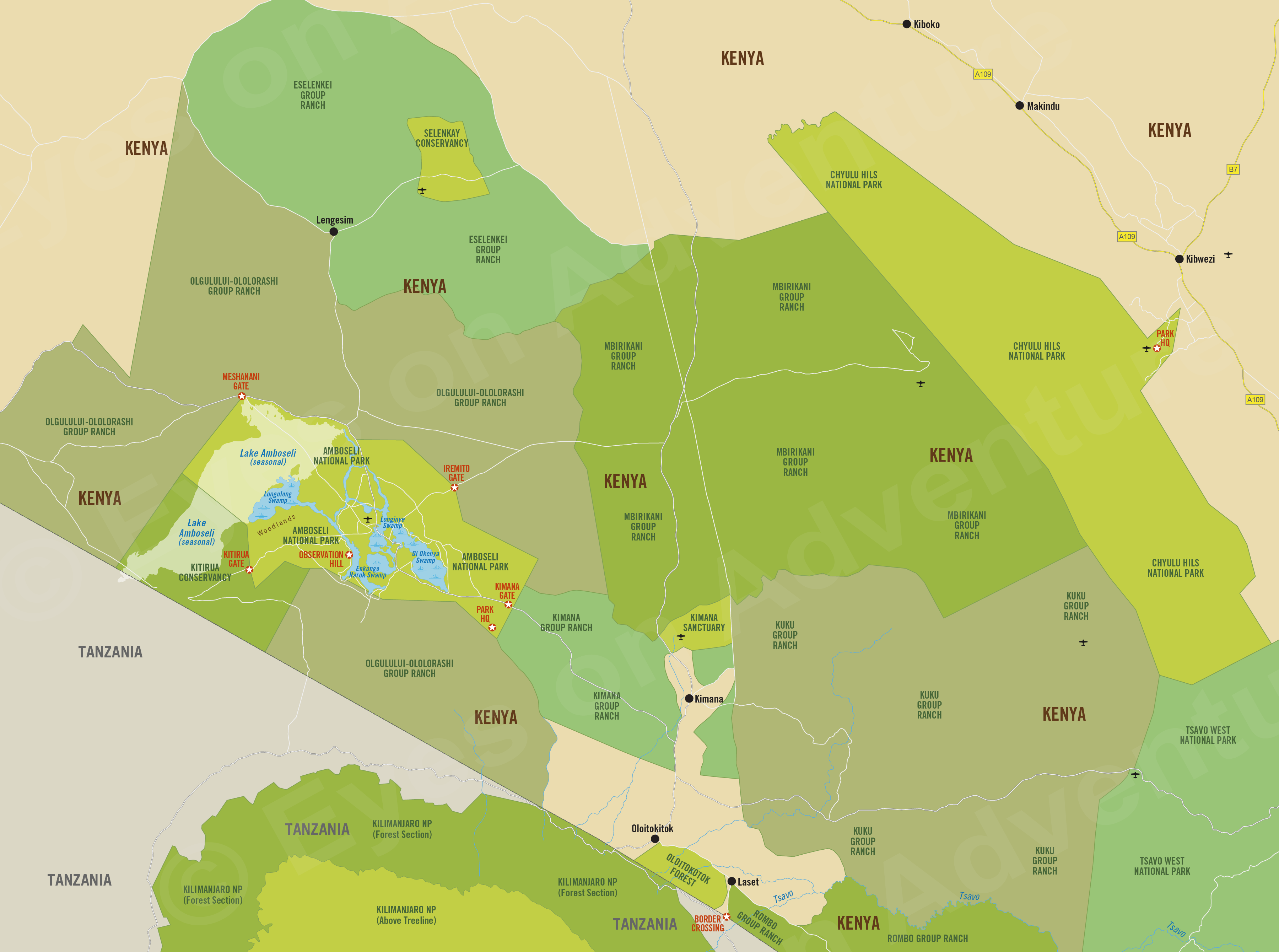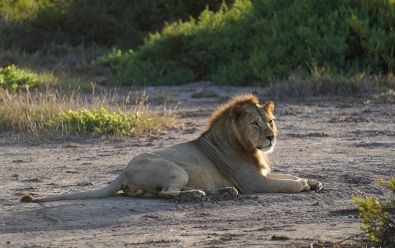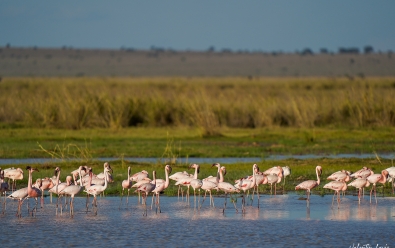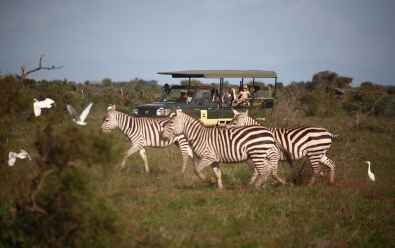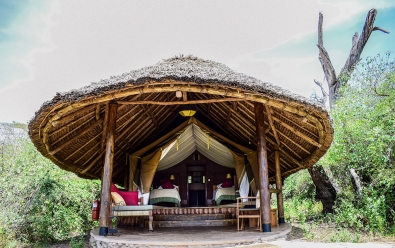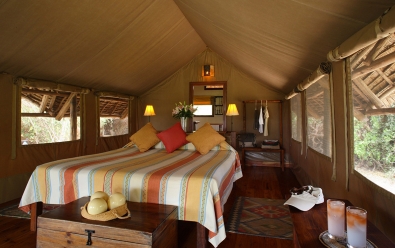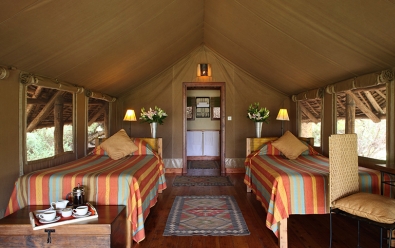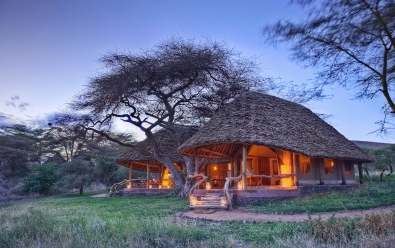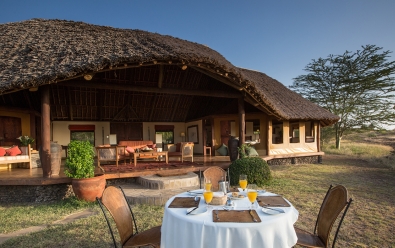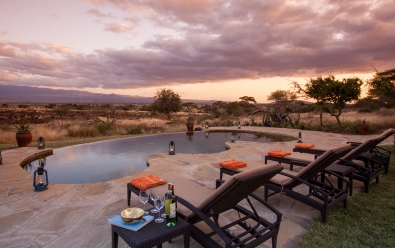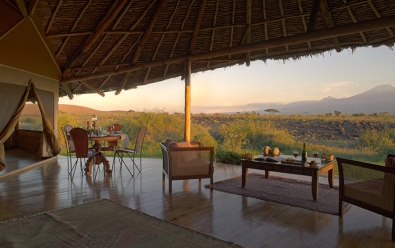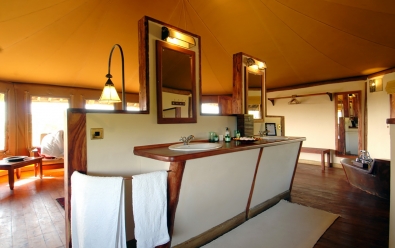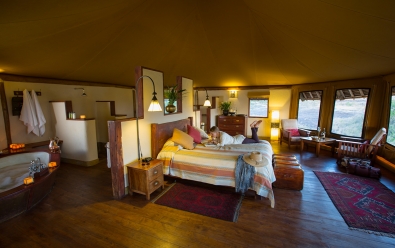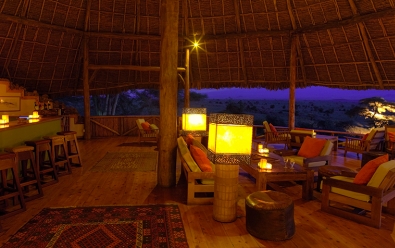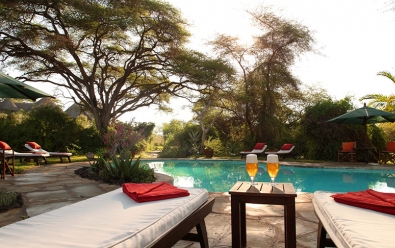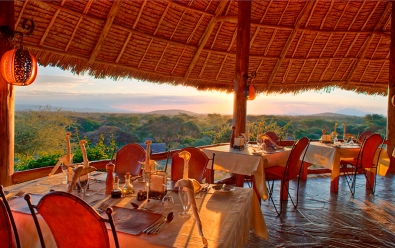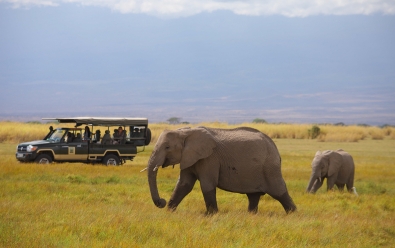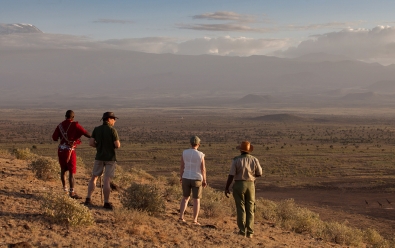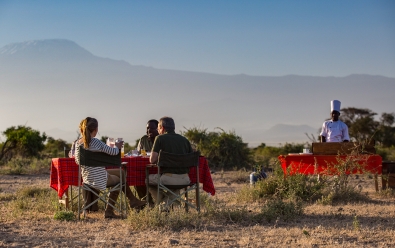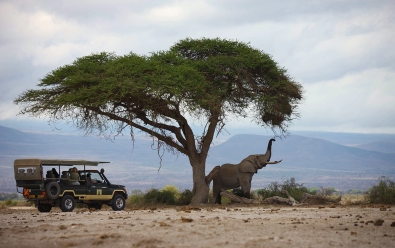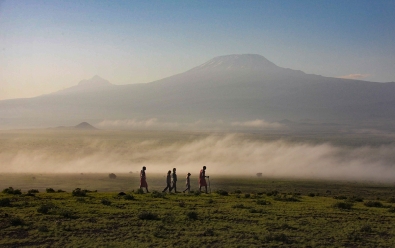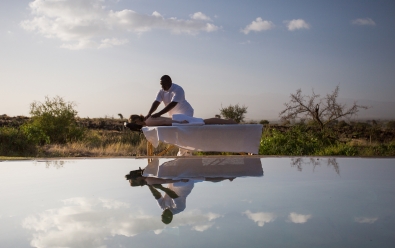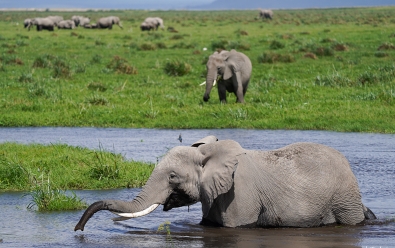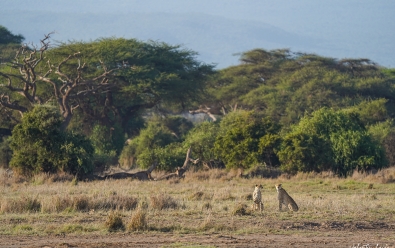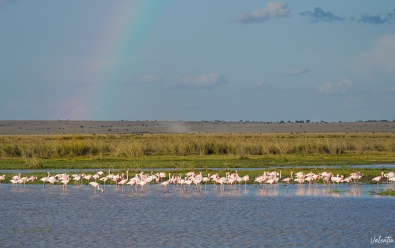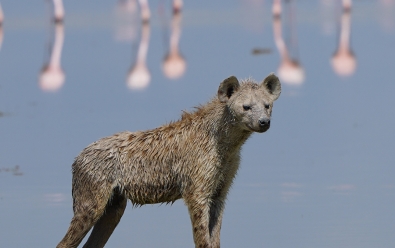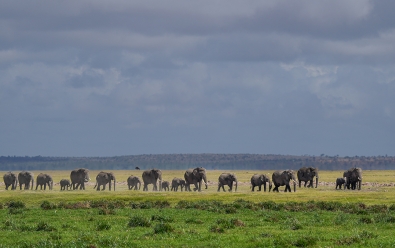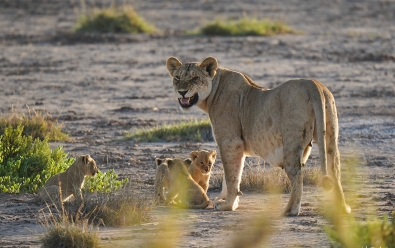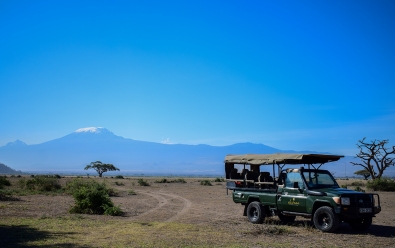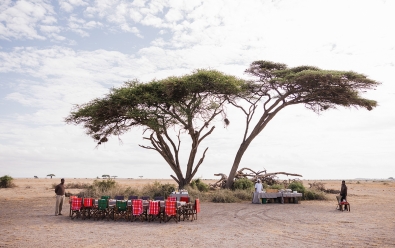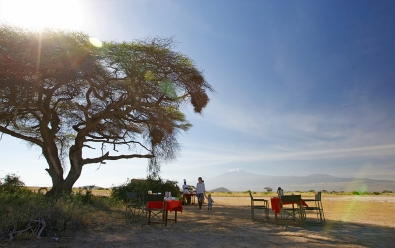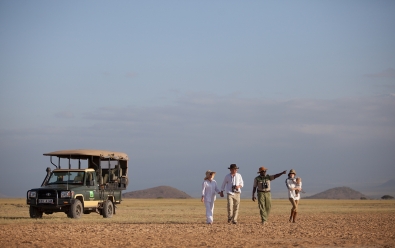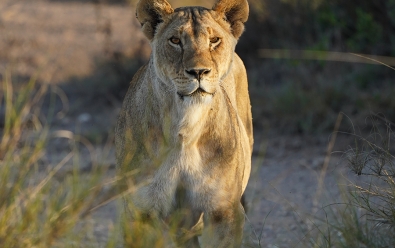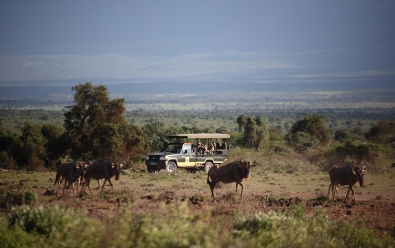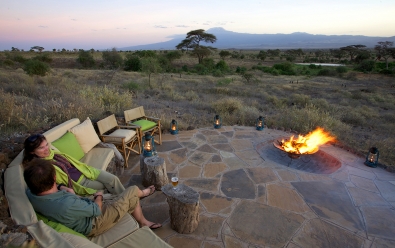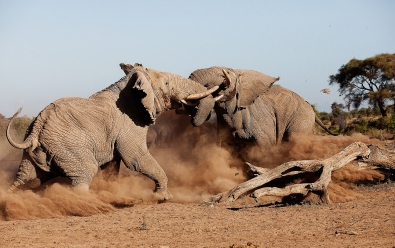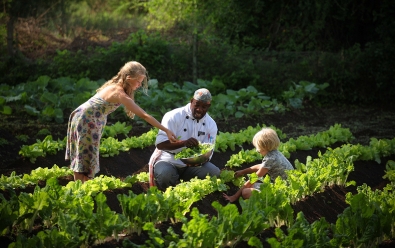Tortilis Camp
Highlights
- In a private reserve with access to the national park
- Excellent wildlife viewing, especially elephants
- Wonderful scenery with Mount Kilimanjaro as a backdrop
- Game drives, walking, and cultural experiences
Location
- Kitirua Conservancy
- Bordering Amboseli National Park
- Southeast Kenya
Tortilis Camp is located near the border of Amboseli National Park in a private conservancy and is perfectly positioned for safaris and views of Mount Kilimanjaro.
The camp is situated far from other safari lodges and just outside the national park in the 52-square mile (135-sq-km) Kitirua Conservancy, to which the camp and its guest have exclusive access. The conservancy was the first in the Greater Amboseli region (established in 1984) and it helps to ensure that both the native wildlife and the Maasai people living on its fringes have access to natural resources, while also providing tourism revenue for the Maasai.
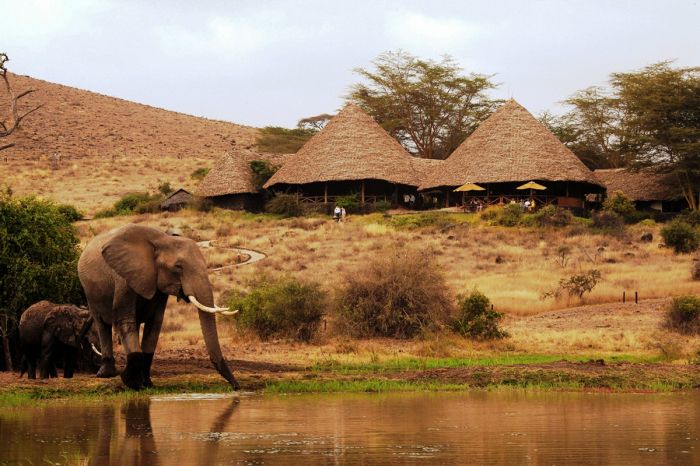
Elephants in front of Tortilis Camp.
The roads in Amboseli National Park can sometimes be busy with game drive vehicles (off-road driving is prohibited in the park), so staying at Tortilis, which is located in a private conservancy, provides a big advantage in terms of low tourist traffic and the ability to do off-road driving and guided walks.
The lodge is built on the side of Liimbarishi Hill with spectacular views across the plains and of Africa's tallest peak, Mount Kilimanjaro, which is located across the border in Tanzania. On days when the air is clear and the mountain is not shrouded in clouds, the view of elephants, zebras, and other wildlife with Kilimanjaro in the background are truly beautiful.
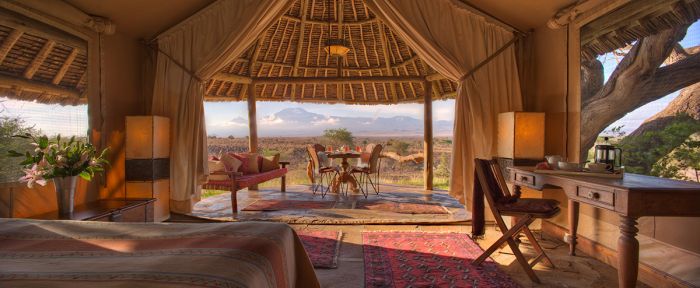
Guest tent bedroom and view to Mount Kilimanjaro.
Activities include game drives in both Amboseli National Park and in the private conservancy. Walking safaris are permitted in the conservancy, but not in the national park. Cultural visits to a nearby Maasai community and school are on offer, as well as visits to the renowned elephant researcher Cynthia Moss’ Elephant Research base camp.
Tortilis Camp offers 16 Meru-style safari tents, as well as a two-bedroom family tent and a larger two-bedroom private house. All tents are convertible to a triple in order to accommodate an additional child. The main guest area includes a swimming pool and a spa. A second swimming pool is shared by the family tent and private house, both of which are located well away from the rest of the camp's guest tents. Tortilis Camp is 100% powered by solar energy.
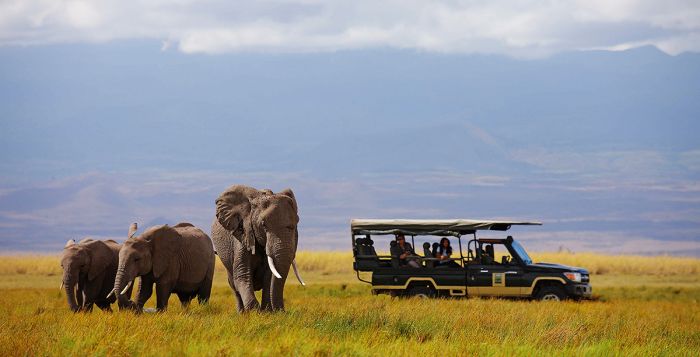
Game drive at Tortilis Camp.
About Amboseli
The Amboseli region is a bridge ecosystem between Tsavo in the east and the Masai Mara-Serengeti ecosystem to the west. This is the spectacular home of Amboseli National Park, which name derives from the Maasai word for "place of dust".
Amboseli is set against the backdrop of Mount Kilimanjaro, located just across the border in Tanzania and the highest peak on the African continent. The seasonally wet Lake Amboseli and the surrounding swamps combine with the vast open spaces, savannas, and woodlands to create a dynamic ecosystem unlike any other in Africa.
Amboseli is perhaps most famous for its elephants, which are here in abundance. The sight of herds walking through the arid landscape with Kilimanjaro as a backdrop is almost too beautiful to believe.
The lands east and north of Amboseli are sparsely populated, with no large urban areas. The land is partitioned into parcels called "Group Ranches" and there are safari camps and various conservation initiatives throughout the region.
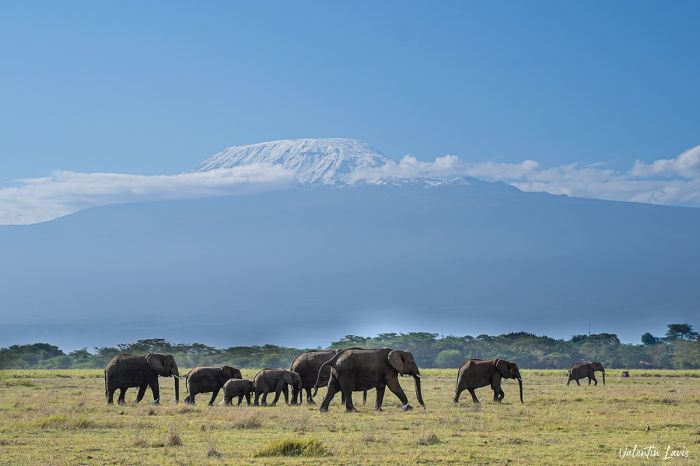
Elephants in Amboseli with Mount Kilimanjaro in the distance. Copyright © Valentin Lavis.
Amboseli National Park
Covering 151 square miles (392 sq kms), Amboseli National Park contains diverse habitats, from open plains, Acacia bush/scrub, large freshwater swamps and marshes fed by streams from Mount Kilimanjaro, and Acacia woodlands.
Most of the open plains in the park are covered with a fine, saline, volcanic ash that was deposited by successive Kilimanjaro eruptions during its active period long ago. During most dry-season days, this volcanic dust becomes disturbed by wind and also by the hooves of the plains game, creating incredible imagery, especially at sunset. Huge 'dust devils', similar to miniature tornados, can be seen blowing across the plains during midday.
Given the dry and seemingly inhospitable landscape in Amboseli, one may at first wonder how so many animals can survive here. The answer is that water from the upper slopes of Mount Kilimanjaro drains into Amboseli via a network of underground streams and resurfaces at its northern base, where they feed into a network of swamps and seasonal lakes in Amboseli.
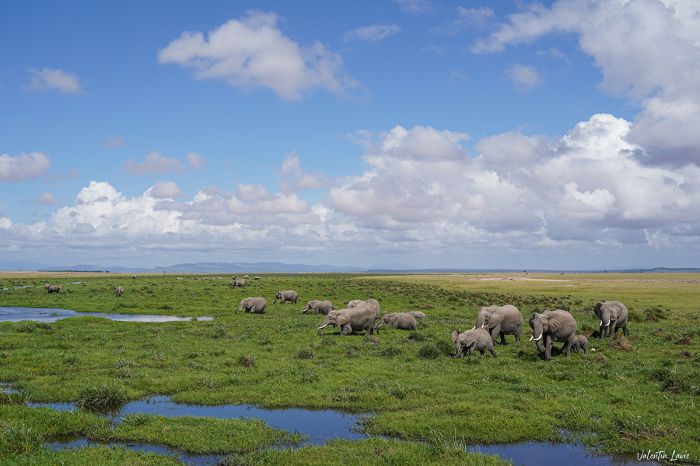
Elephants in Amboseli National Park's marsh area. Copyright © Valentin Lavis.
The large Lake Amboseli in the west is usually bone dry, but when substantial rains arrive, the shallow lake retains enough water to attract flamingos and pelicans, and the entire area transforms from a dry and dusty lake-bed into a lush oasis for wildlife.
The national park itself is small and can be somewhat crowded with tourists. That said, the amazing elephant herds and towering Mount Kilimanjaro as its backdrop combine to make Amboseli an incredibly scenic place to visit.
Mount Kilimanjaro, as seen from the national park, is massive and fills much of the sky to the south, but is often shrouded in clouds at its upper elevations. Sunset and early morning are the best times to see the mountain, and seasonally, the most consistent views are during the rainy season, when the air has less dust.
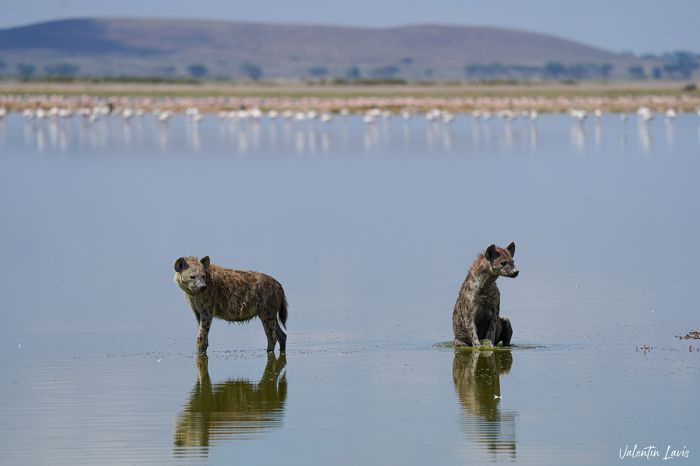
Spotted hyenas and lesser flamingos in Lake Amboseli after rains. Copyright © Valentin Lavis.
Wildlife
Amboseli is a haven for hundreds of elephants and the herds are numerous and include many 'big tuskers'. The predators here are not easily seen, aside from the jackals and spotted hyenas. The once prevalent lions never recovered from historic persecution by the Maasai, and cheetahs are only rarely encountered. Leopards are present, but extremely elusive.
Herbivores are present in abundance, with zebras, giraffes, and buffalos the most common. There are also good numbers of impala, blue wildebeest, Thomson's gazelle, Grant's gazelle, and the unique gerenuk antelope, with its ultra-long neck. Baboons are found in good numbers in the areas with trees and around the swamps.
Birding is excellent, especially in the permanent swamps at Enkongo Narok and Ol Okenya and also in the acacia woodlands. Over 400 species have been recorded in the region.
During the dry season, much of the wildlife is concentrated into the swamp/marshy regions and into the patchwork of acacia forest for their abundant food sources. After the rains have started, the animals disperse and are much more spread out into the surrounding areas.
The park is small and easily covered in a couple days, but may be worth staying longer to get more chances at great photographs. The marshes have water all year and hippos can be seen at any time.
ROOMS INCLUDES & EXCLUDES CHILDREN FACILITIES ACTIVITIES
Accommodation
18 guest accommodations in total comprising:
- 16 Meru-style, canvas safari tents. Nine of the tents have a double bed, while the other seven have twin beds.
- 1 double-size, family tent consisting of a master bedroom with a double bed plus second bedroom with two twin beds. Both bedrooms have en-suite facilities and each can fit one extra bed for a child under the age of 16 years. There is a spacious outdoor veranda shared by the bedrooms. A semi-private outdoor pool is shared with the private house.
- 1 private house consisting of two bedrooms, one a double and the other a triple with 3 twin beds. Both bedrooms have en-suite facilities. There is a shared lounge and dining room and a spacious outdoor veranda. A semi-private outdoor pool is shared with the family tent.
The spacious, Meru-style tents are constructed using wooden supports with canvas walls and ceilings and thatched roofing atop slightly elevated wooden floors with throw rugs. Every tent includes en-suite facilities with a double-basin vanity, indoor shower, and flush toilet. The family room and private house also have a bathtub. The tents are accessed via stone footpaths on the ground leading to the main camp area.
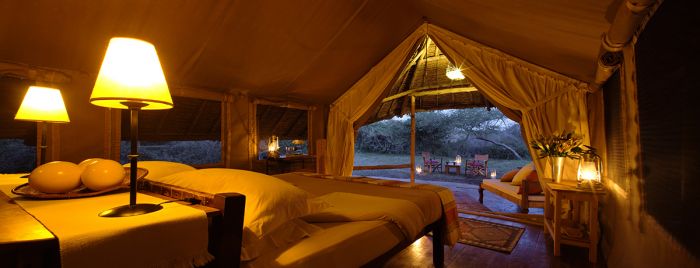
Guest tent interior at Tortilis Camp.
The camp and tents are arranged with views looking towards Mount Kilimanjaro, which is visible on clear days. Each guest tent has a stone veranda in front with an overhanging thatched roof and outdoor seating, providing views across an open plain and Kilimanjaro in the distance. Wildlife is commonly seen from the camp.
The family tent and private house are located at the top of a low hill and separate to the rest of the tents, each offering superb views of the mountain and sharing a private swimming pool.
The tent interiors are furnished with metal and wood furniture, elegant fixtures, and Indian-style throw rugs.
The standard tents are comfortably sized, covering 345 square feet (32 sq meters). The family tent is much larger, covering 882 square feet (82 sq meters) and the private house even more spacious, covering 1 507 square feet (140 sq meters).
Other items and features in the guest tents include:
- Outdoor veranda.
- Writing desk and chair.
- Clothes wardrobes.
- 24-hour solar-power lighting.
- Bathrobes and slippers.
- Safe.
- The camp's solar power cannot support hairdryers. A hairdryer is available for use at the swimming pool changing area. The family tent and private house each have hairdryers.
- WiFi available in the guest tents and main guest areas.
- Mobile phone signal available, but limited.
Tortilis Camp can accommodate a maximum of 41 guests in total: 2 persons in each of the 16 standard tents, 4 persons in the family tent, and 5 persons in the private house. Additional children may be accommodated, as all tents are convertible to triples.
Includes & Excludes
Includes:
- All meals and local beverages including soft drinks, house wines, local brand spirits and beers, teas, and coffees.
- Safari experiences (twice-daily game drives, walking safaris, and birding) accompanied by an experienced guide.
- Sundowners and bush breakfasts.
- Laundry services are provided on a daily basis (weather permitting, items will be returned on the same day). Laundry is dried by the sun and on most days any laundry placed out in the morning will be returned by the evening.
- Wi-Fi access (throughout the entire camp).
- Amboseli Airstrip transfers.
- Tourism Levy & VAT.
Excludes:
- Champagne, cognacs, fine wines, and premium brand spirits.
- Cultural visits.
- Massages, manicures, and pedicures.
- Visit to Cynthia Moss’ Elephant Research base.
- Visit to school supported by Land & Life Foundation.
- Any applicable wildlife fee, park fee, reserve fee, concession fee, other land-use fee.
Single Supplement
A single supplement may apply for any room booked by a single traveler; please ask us for pricing.
Children
Children of any age are accommodated at Tortilis Camp:
- All tents convertible to triples.
- Ask us about reduced rates for children sharing with adults or children 12-17 in their own tent.
- Child-friendly activities are offered.
- Children's menu available.
Some of the children's activities include:
- Swimming pool.
- Guided camp “bush” walks - short walks looking at the trees, flowers, grasses, insects, birds and bird calls, mammals, tracks, and droppings.
- School visit - normal term times and extra cost.
- Warrior training - learning how to make a fire, throw the Masai rungu and make and use a bow and arrow (extra cost).
- Jewelry making - learning how to make necklaces and bangles with local Masai villagers (extra cost).
Facilities
The camp and tents are located just outside the southern boundary of the national park in a grove of Umbrella-thorn trees. The scientific name of this tree is Acacia tortilis, from which the camp gets its name.
The main guest area is situated on a hill overlooking a pumped waterhole, which attracts wildlife. The main structure is an open-air lounge, dining room, and bar under a high-pitched thatch roof and atop a slightly raised stone floor.
Main guest area facilities include:
- A single open-air structure comprising lounge, dining, and bar areas.
- Large swimming pool and sun deck.
- A changing room and bar are located at the pool.
- A second swimming pool is located between the family tent and private house, for their private use.
- Spa.
- Campfire area.
- Vegetable garden.
- Complimentary Wi-Fi access.
- Electronics charging facilities.
- Mineral water is provided from dispenser points in the main camp areas. Mineral water provided during meals and in guest tents. Guests are issued with a refillable bottle.
- The camp is 100% powered by solar energy; a backup generator is used only for cloudy days if necessary.
Activities
Activities included in the rate:
- Morning and afternoon/evening game drives in open 4x4 vehicles.
- Night drives also offered.
- Game drives into Amboseli National Park as well as in the Kitirua Conservancy. Tortilis Camp has exclusive use of this exclusive area, which covers 52 square miles (135 sq kms) and off-road driving is permitted.
- Guided bush walks. Children under 16 years of age may be restricted. All bush walks are subject to the discretion of the lead guide due to the nature of the activity.
- Bush breakfasts and sundowners.
- Birding.
- Child-friendly activities.
- All game drive vehicles are fitted with inverters for battery charging on game drives.
Optional activities at additional cost:
- Private activities are on offer (subject to vehicle availability, which needs to be booked in advance).
- Visit to Cynthia Moss’ Elephant Research base.
- Guided visit to a local school supported by Land & Life Foundation.
- Guided cultural visit to a Maasai village.
- Spa treatments.
Example of a typical day:
- Early morning wake-up call. Morning wake-up and activity times vary according to the seasons, activities on offer, and wildlife sightings.
- Light breakfast before departing on the morning activity or food packed for a bush breakfast.
- Return to the lodge for a meal and rest period (for full-day outings, a lunch is packed).
- Meet for afternoon tea and snacks (savory and sweet choices) before departing on the activity.
- Return to camp - freshen up or meet for drinks, followed by dinner.
- Enjoy a nightcap and/or discussion at the bar or around the campfire before retiring.
Great Good Fair Poor
- Jan
- Feb
- Mar
- Apr
- May
- Jun
- Jul
- Aug
- Sep
- Oct
- Nov
- Dec
GENERAL TIPS
Amboseli is a very good destination for much of the year, but the recommended time is during the dry months between June and October and again in January and February. This said, visiting Amboseli during the rainy months can also be great if you are lucky with some sunny days, as the marsh areas and Lake Amboseli often become spectacularly good for wildlife viewing when there have been good rains.
The Amboseli region experiences most of its rain between November and May, but there are two somewhat distinct rain seasons, the 'short' rains and the 'long' rains.
The entire area is prone to drought, during which time plants and animals fight for their survival and demonstrate an amazing ability to survive.
Tortilis Camp is open year-round. Minimum 2-night stay.
Temperatures
The temperatures in the Amboseli region do not have great variation throughout the year, as it lies only 2-3 degrees south of the equator. In general, daytime temperatures are comfortably warm and overnights and early mornings are chilly. Bring a fleece layer regardless of the timing of your visit.
Dry Season
The dry season (June to October) is sunny and warm most days and there is almost never any rain. From June thru August, the afternoon temperature averages 75-79°F (24-26°C), but some days can be warmer. Evenings and early mornings temperatures are often chilly, averaging 57-59°F (14-15°C).
September and October days are very pleasant, with temperatures averaging 80-84°F (28-39°C), with cool mornings persisting, averaging 57-59°F (14-15°C).
During the dry season, Amboseli is an arid, dusty place, with Mount Kilimanjaro covered in heat haze on most days. Despite the dust, photographers will love this time of year, as swirling dust-devils (like miniature tornados) cross the dried plains, sucking clouds of dust hundreds of feet up into the air, making for amazing imagery. Zebras, impalas, giraffes and elephants also kick up dust, making for some incredible imagery. Sunsets during the dry season are also spectacular.
Rainy Season
The rainy season is November through May (read more below) and the temperatures are fairly static throughout the season. Daytime temperatures average 80-85°F (27-29°C) and nighttime and early morning temperatures are cool, but slightly warmer than the dry season, averaging 61-63°F (16-17°C).
Rainy Season
Short Rains
The short rains occur for about one month sometime during November and December (the exact time varies somewhat year to year). This period is called the 'short' rains because the duration of an individual rain event is short and it is rare to have an all-day rain event. Most rain falls as an afternoon shower, while mornings are typically overcast or clear.
Long Rains
The long rains occur between March and May, with April being the wettest month of the year. During this time, rain should be expected almost every day and the showers can last for hours at a time, although all-day rain is not typical. During the long rains, the roads in the Amboseli area can become muddy and difficult in places, which can hamper game drives. Cloudy skies are typical and temperatures can be chilly at times.
The period between the short and long rains (January and February) also receives rain, but many days are clear and the amount and duration of the rain events is unpredictable, with some afternoon showers and the odd long and heavy rainfall event.
The rainy season (during good rain years) transforms the national park into a verdant landscape, with Lake Amboseli and other seasonal ponds and lakes becoming partially filled with rain water. These oases of life attract flocks of flamingos, pelicans, and other migratory bird life, creating an amazing spectacle. Some of the elephants and other wildlife disperse into the surrounding areas if the rains have been especially good.




